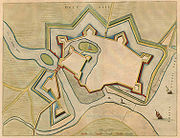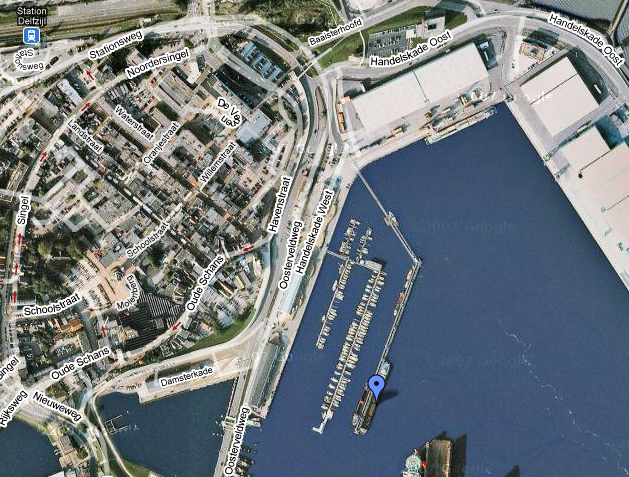| Dockings and Events |
|
| Museumship Vlotburg in Delfzijl starts on 26.09. till 05.10.2009 |
 |
See location map below.
The name "Delfzijl" means Side (= lock) in the Delf (= the old name of the Damsterdiep). Delfzijl originated in the thirteenth century when a lock was built in the Delf. Yet there was a long time of occupation of the area where the current is Delfzijl. The Roman Pliny the Elder [1] already wrote in AD 47 over the area on the banks of the Ems. In his journal he mentions the original inhabitants, who belonged to the Chauken and lived on mounds or wierden. So they were protected against the tide twice a day.
Yet this is not the first sign of habitation in Delfzijl. In 1982 in the immediate vicinity of Delfzijl, in the east of Delfzijl terp Heveskesklooster a Hunebed found. This is an indication that even in early times, habitation was in Delfzijl.
Delfzijl The name was first mentioned in a charter of June 19, 1303. Originally there were three Zijl (locks) in the Delf. These were Slochteren, Scharmer-Star Village and called Side. It is also speaks of "the three Delfzijl. This locks came quickly when a residential lock keeper was appointed. This was the beginning of the emergence of the current Delfzijl. The three locks fell under the Military Vest Zijl Three of Delfzijl.

The three locks in the Delf formed an important strategic point. They were not only used to discharge to the inland sea, but could also be used for the seawater to flow over the land. Moreover, an important trade route from Delfzijl of Groningen controlled. Also, the traffic on the Ems was checked and if the vessels in the port of Emden hindered. The port city was also a basis for a large invasion force from the sea. In 1499 the Count of East Friesland a blockhouse built in Delfzijl.

On July 25, 1568 visited Alva Delfzijl. He saw the strategic importance and made plans for a major stronghold of it. Originally it was his intention to make a fortress which Delfzijl, and Farmsum Appingedam would belong. This was against the very meaning of Groningen and by repeated calls of Groningen not continue. By order of the Count of Rennenberg the defenses were even dismantled. The same Rennenberg gave some time later however order to Johan van den Kornput a design for the reinforcement of Delfzijl. This plan was not executed right. There was first a fort, surrounded by a moat, built by Berthold inoculating Mentheda to Middelstum [2]. This fort was occupied by the Spaniards in 1580. In 1591 the fort was retaken by Prince Maurits. He supervised the strengthening of the ramp and so was the plan of Johan van den Kornput still be performed. Delfzijl became a fortress. In 1594 Francisco Verdugo was a vain attempt to take back Delfzijl fortress. In 1696 the fortress was strengthened by Menno van Coehoorn.

A 17th century map of the fortress Delfzijl
In the Middle Ages there were several near Delfzijl Borgen.
Port of Delfzijl was already in the 16th century in different maritime writings indicate. In 1591 Prince Prince Maurice visited the port with a fleet of 150 ships. Some decades later visited Piet Hein with the "treasure fleet" Delfzijl. During the Second English-Dutch War in 1665 came Michiel de Ruyter in the West Indies fleet he captured thirty ships in the port of Delfzijl.
Delfzijl in 1825 received city rights. In 1856, the naval academy founded. In 1876, the Eemskanaal of Delfzijl Groningen dug.
Source: http://nl.wikipedia.org/wiki/Delfzijl
Location: Handelskade West

Source: Google Maps
|
|
 |
|
| |
|
|
|

